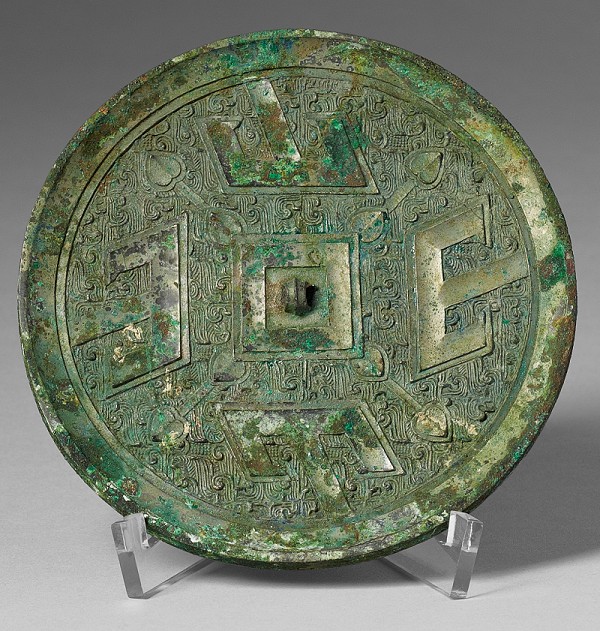
Bronze mirror. China, Eastern Zhou/Warring States period. Diameter 12 cm.
Provenance: Axel Lagrelius (1863-1944). Thence by descent.
A similar 'shan' ("mountain" characters) mirror is in the collection of the Museum of Far Eastern Antiquities, Stockholm, illustrated in Bulletin of the Museum of Far Eastern Antiquities, no. 9, 1937, pl. LX.3. This mirror described in Lagrelius's original collection catalogue; No. 30: Bronze mirror of so called Shan-type, after the main decoration resembling the character Shan; meaning mountain. It is repeated four times. The ground is decorated with spirals. The type is very common and does not exist solely with four Shan (T-resembling) but with 1 to 7 of the same kind. It is one of the earliest types of decorated mirrors and dates to 6th – 3rd Century. This is the most exquisite and flawless example that I have seen. I bought it, if I remember correctly in Chengchou in Honan. The patina greyish green with encrustations. Was part of the Chinese art exhibition in London 1935-36 and is illustrated in the catalogue (no. 425).
Jan-Erik Nilsson Collection, 2014
As early as 2000 B.C., bronze technology was highly developed in China, and objects made from this alloy of copper, tin, and lead were considered luxury items, reserved for the aristocratic class. They were given as gifts to and by emperors and common people alike. They could, it was believed, dispel evils and so mirrors become a favorite burial accessory. A pottery tomb figure dating to about the first century B.C. depicts a woman gazing into a mirror while applying powder to her face.
Mirrors were more uniform and typically round in Han Dynasty (206 BC-220 AD) while greater variety is observed in the Song and Yuan dynasties (10th-14th century) when different forms, such as oblong and octagonal appeared. Some mirrors have a handle or eyelets for hanging. In the last few centuries, during the reign of the Qing dynasty (1616-1911), bronze mirrors were gradually replaced by glass mirrors.
Usually cast from clay molds, they were highly polished on one side, offering a reflective surface, while the other side was decorated with intricate patterns and designs that reveal an astonishing level of skill and artistry in their craftsmanship.
Among these coveted pieces were small bronze mirrors, some compact and portable enough to be held in one hand, and others large and heavy enough to require stands. The back is often decorated with a button and various motifs such as phoenix, beasts, flowers, leaves and lattice. Some also have inscriptions. Changes in style and decorations between different historical periods reflect the evolution of social and cultural ideas and preferences.
Birds, dragons, and serpents were common motifs in the earliest mirrors. Later, more sophisticated and intricate designs included mythological figures, deities, animals of the Chinese zodiac, abstract patterns, background textures, inscriptions, enamel work, and inlays of jade, turquoise, and mother-of-pearl.
That these mirrors were prized by their owners is evident not only in light of their fine craftsmanship but also because of related artifacts that point to how they were valued.
Ancient Chinese used mirrors in various social functions. Since the nature of reflection is somewhat mysterious, people were prone to associate mirrors with the supernatural. In the Buddhist and Taoist rituals bronze mirrors were with its light-reflecting property important worship paraphernalia.
A